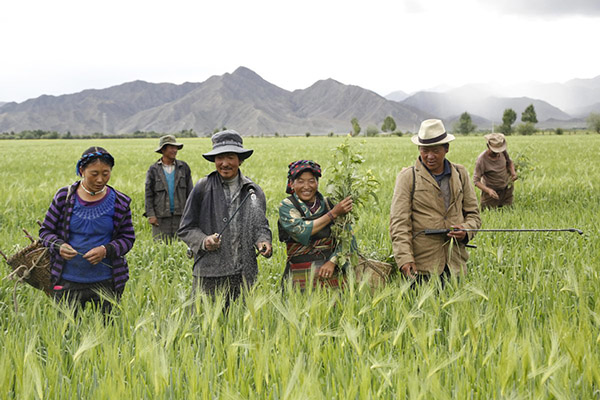Need to widen the scope of Tibetan studies
Updated: 2021-05-25 By Yang Dan (China Daily)  Print
Print 



Workers from the Tibet Academy of Agricultural and Animal Husbandry Sciences teach local farmers to grow highland barley in Panam county of Shigatse, Tibet autonomous region. DAQIONG/CHINA DAILY
According to the 14th Five-Year Plan (2021-25), China is committed to following a new development paradigm and promoting high-quality development in the new era. Among other things, this requires scholars to develop a new pattern of research on Tibet. And scholars can do so by following certain principles.
First, they should focus on systematic planning for Tibetan studies-an area in which China Tibetology Research Center has done a great deal of work. To better tell China's story, it is also necessary to include international researchers in Tibetan studies and promote linguistic and cultural research across borders and in neighboring regions. For this, they need to make clear the research themes including research based on Tibet's unique natural conditions, and interactions between man and nature. Such research can extend from ecology and anthropology to sociology and economics.
Second, from the perspective of time, researchers should analyze past and present-day research to determine the future course of studies. Current studies on Tibet are mostly limited to five or 10 years. For example, after using satellite images to study the changes in the Himalayan glaciers from 1975 to 2016, Columbia University and the University of Utah concluded that their thickness decreased by 0.25 meter a year from 1975 to 2000, and at double the rate between 2000 and 2016.
The United Nations Intergovernmental Panel on Climate Change, too, has said the Qinghai-Tibet Plateau is warming twice as fast as the rest of the world, by 0.3 degrees Celsius a decade. In fact, glaciers on the Qinghai-Tibet Plateau have melted at a much faster rate in the past 50 years than in the preceding 2,500 years. Yet few studies have been conducted in this area.
Research on Tibet needs to expand in scale and time to also help China fulfill its commitment to peak carbon emission before 2030 and realize carbon neutrality before 2060.
And third, in terms of space, Tibet has an area of 1.22 million square kilometers, second only to the Xinjiang Uygur autonomous region in China. It is about the size of South Africa (the world's 24th largest country), five times the size of the United Kingdom, three times the size of Japan, and two times the size of France. Therefore, studies on Tibet must have a global perspective.
A study conducted by the London School of Economics on the economic growth of nearly 700 regions in the world showed that, thanks to the reshaping of economic space, the world's economic center of gravity has been shifting from one region to another. From the Roman Empire to the mid-20th century, the center of economic gravity moved westward with the rapid industrialization of Europe and North America.
After the rise of emerging markets in Asia and elsewhere, the center of gravity began shifting back to the East and South, and the global economic center of gravity in 2050 is likely to be India and China, which will include Tibet.
In this regard, we have conducted some research, including surveys on people's livelihood in Tibet's farming and pastoral areas and the region's future economic and industrial development. The household survey on people's livelihood in agricultural and pastoral areas in Lhasa from 2017 to 2019 covered 746 households from 62 villages in the first year, for which we traveled over 60,000 kilometers, equivalent to one and a half times the circumference of the Earth.
In the following two years, we expanded the scope of the survey's samples based on the tracking of the previous samples. The study found that the overall livelihood satisfaction score in Lhasa's agricultural and pastoral areas was 93.33, within the "very satisfied" range. As a matter of fact, the overall score in Lhasa's agricultural and pastoral areas improved from 79.12 in 2017 to 90.98 in 2018 and 93.33 in 2019. Which means people's livelihoods greatly improved in the three years.
However, the survey also found that more efforts are needed to remove the factors affecting people's livelihoods and expand public transportation and healthcare infrastructure so that farmers and herdsmen can more easily access medical services.
Our research on Tibet's economic development has added a third dimension to the previous studies. Altitude is a key factor that determines economic growth in any region, especially on a plateau. And by analyzing Tibet's geographical and economic features as part of overall Tibetan studies, and examining the region's endowment structure, natural and human resources, hard and soft power, and other aspects, we can determine which industries are best suited to flourish in Tibet.
The views don't necessarily reflect those of China Daily.
The author is president of Beijing Foreign Studies University.
If you have a specific expertise and would like to contribute to China Daily, please contact us at opinion@chinadaily.com.cn, and comment@chinadaily.com.cn.








